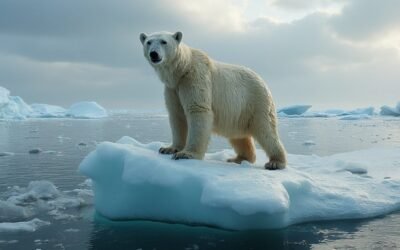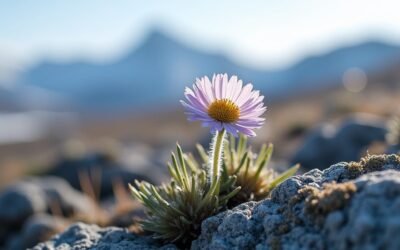Have you ever wondered how animals adapt to the extreme conditions of the Arctic? The Svalbard reindeer is a prime example of such adaptation, showcasing a remarkable ability to survive in one of the planet’s most challenging environments.
The Svalbard reindeer stands out for its unique adaptation to the harsh Arctic climate. It undergoes significant seasonal weight fluctuations, gaining and losing substantial fat reserves as an adaptation strategy. This not only helps them through the frigid Arctic winters when vegetation is scarce but also highlights their evolutionary journey towards developing shorter legs and rounder bodies to maximize heat retention.
However, this adaptation, while beneficial, underscores their potential vulnerability to the accelerating climate changes in the Arctic. The balance between their physiological adjustments and the escalating environmental pressures presents a delicate equilibrium of resilience and susceptibility. This scenario invites a broader discussion on the future of the Svalbard reindeer in a rapidly changing world, offering a high-level overview of the challenges and adaptations faced by these unique creatures.
Key Takeaways
- Svalbard reindeer demonstrate remarkable adaptation to Arctic conditions, highlighting the diversity of survival strategies in nature.
- Their specialized diet and unique behaviors are key to thriving in the sparse tundra, showcasing their evolutionary advancements.
- Conservation efforts have been effective in increasing the population of Svalbard reindeer, proving the value of targeted protection measures.
- Climate change poses a significant threat to their habitat, emphasizing the need for ongoing research and adaptation strategies to protect these animals.
- The recovery of the Svalbard reindeer from near extinction serves as a powerful example of successful biodiversity preservation efforts.
Scientific Classification
Taxonomic Evolution of the Svalbard Reindeer
Origins and Renaming
The journey of understanding the Svalbard reindeer began in 1829 when it was first classified as Cervus (Tarandus) platyrhynchus. However, a significant shift in its taxonomic classification occurred in 1912, when Miller Jr. reclassified it as Rangifer platyrhynchus. This change was more than just a new name; it reflected a deeper understanding of the reindeer’s unique genetic and ecological traits. The renaming marked a key moment in recognizing the Svalbard reindeer as a distinct species within the vast tapestry of wildlife.
Genetic Insights
The uniqueness of the Svalbard reindeer goes beyond its physical adaptations. Genetic research has unveiled the significant genetic divergence that sets these reindeer apart from their cousins. These studies have shown that the Svalbard reindeer’s genetic material contains unique markers, underscoring their evolution as a separate species. Such genetic distinctiveness is a testament to the reindeer’s long history of adaptation and survival in the harsh conditions of the Svalbard archipelago.
Adaptation to Harsh Conditions
Surviving in the Svalbard archipelago demands exceptional adaptations, and the Svalbard reindeer have risen to the challenge. Research into their habitat adaptations reveals a suite of physiological and behavioral traits that enable them to thrive in extreme cold and scarce food conditions. These findings shed light on how the Svalbard reindeer have carved out a niche for themselves, mastering the art of survival in one of the planet’s most inhospitable environments.
Conclusion on the Svalbard Reindeer’s Place in Evolution
The combined efforts of taxonomic classification and genetic research have firmly established the Svalbard reindeer (Rangifer platyrhynchus) as a distinct species. This recognition isn’t just a matter of scientific nomenclature but highlights the reindeer’s remarkable journey through evolutionary history. Their story is a vivid illustration of nature’s adaptability and the intricate relationships that define our planet’s biodiversity.
Habitat
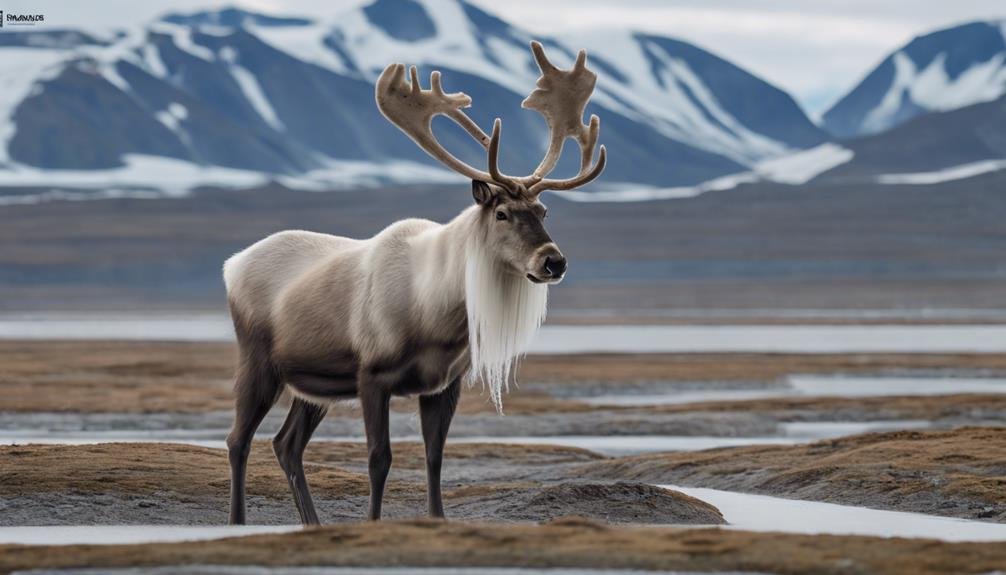
Exploring the Habitat of the Svalbard Reindeer
Habitat Overview
The Svalbard reindeer have adapted to thrive in the harsh conditions of Svalbard, preferring areas that are free from ice. Nordenskiöld Land, Edgeøya, and Barentsøya stand out as prime locations for these animals. The key to their survival lies in the unique landscape and vegetation available in these areas, particularly during the brief Arctic summers.
Nordenskiöld Land: A Verdant Refuge
In Nordenskiöld Land, the landscape is predominantly non-glaciated, providing an abundant supply of tundra vegetation. This area is a vital feeding ground for the Svalbard reindeer, allowing them to build up the necessary fat reserves for the long winter ahead.
Edgeøya: Winter’s Pantry
Edgeøya is characterized by its minimal snow cover, which is a significant advantage for the reindeer during the winter months. The reduced snowfall means that food is more accessible, helping the reindeer to maintain their condition even in the coldest parts of the year.
Barentsøya: Surviving the Winter
Similar to Edgeøya, Barentsøya provides a supportive environment for the reindeer when food becomes scarce. The ability of the Svalbard reindeer to utilize these areas during the challenging winter months is a testament to their adaptability and resilience.
Adapting to Winter Hardships
With the onset of winter, the Svalbard reindeer show remarkable adaptability by feeding on ridges, slopes, and plateaus where snow is less likely to accumulate, making it easier to access food. However, the late winter and spring bring about a scarcity of food resources, which can significantly impact their numbers. This period is critical for their survival and demonstrates the intricate relationship between these animals and their habitat.
Conclusion
The resilience of the Svalbard reindeer and their ability to adapt to the extreme conditions of their habitat underscore the importance of these specific regions in Svalbard. The unique characteristics of Nordenskiöld Land, Edgeøya, and Barentsøya not only support the survival of these remarkable animals but also play a crucial role in their population dynamics. Understanding the habitat preferences and adaptations of the Svalbard reindeer is key to appreciating the delicate balance of life in the Arctic.
Diet

Dietary Habits and Winter Survival
The Svalbard reindeer rely on a diet that’s rich in tundra vegetation, including grasses, herbs, and shrubs during the Arctic summer. This diverse intake is crucial for building up fat reserves, which are indispensable for their survival during the harsh winter months. Unlike other species that might broaden their diet when resources are scarce, Svalbard reindeer are selective and exclude arctic white-heather from their diet. This selective feeding is a testament to their adaptation to the challenging conditions of the Arctic tundra.
Foraging Strategies and Adaptation
To cope with the winter scarcity, Svalbard reindeer adjust their foraging patterns, focusing on areas with less snow. This strategic behavior ensures they can access vegetation throughout the winter. Their diet isn’t just about survival; it also plays a significant role in their physical adaptation. The nutrients from their food intake are pivotal in enhancing the insulation properties and camouflage capabilities of their fur, adding a crucial layer of protection against the cold and predators. This symbiotic relationship between diet and physical adaptation underlines the intricate balance of life in the Arctic ecosystem.
The Role of Diet in Physical Attributes
The vegetation consumed by the Svalbard reindeer does more than just provide energy. It contributes essential nutrients that fortify their fur, making it a better insulator and improving its camouflage. This adaptation is vital for enduring the Arctic winter and evading predators. The diet of these reindeer is a key factor in their survival, influencing not only their ability to store fat but also enhancing their physical characteristics to thrive in one of the planet’s most extreme environments.
Behaviour

Svalbard Reindeer’s Seasonal Adaptations
Summer Strategies for Survival: During the warmer months, Svalbard reindeer form small groups, typically comprising around five individuals. This grouping is particularly effective for grazing across vast areas, ensuring that each reindeer can consume enough vegetation to build up fat reserves. These reserves are vital for enduring the long, harsh winter ahead.
Winter’s Approach and Group Dynamics: With the onset of winter, these reindeer transition into even smaller groups. This adjustment is a direct response to the reduced availability of food. By forming smaller units, they can minimize competition for the scarce resources available, a crucial strategy for survival during the challenging winter months.
Interaction with Humans: Despite the extreme conditions they live in, Svalbard reindeer display a noticeable curiosity towards humans. They often approach visitors, demonstrating an intriguing blend of caution and curiosity. This behavior highlights their ability to assess and adapt to their environment, including the presence of humans.
Building Reserves for the Cold: The primary focus for Svalbard reindeer, regardless of the season, is to find enough food to sustain themselves. The accumulation of fat during the summer and efficient feeding during the winter are critical for their survival. This continuous cycle of adaptation demonstrates the reindeer’s incredible resilience.
Adapting to the Seasons: The ability of Svalbard reindeer to adjust their group sizes in response to seasonal changes is a testament to their survival strategies. Whether it’s forming larger groups in summer to maximize food intake or smaller ones in winter to reduce competition, these adaptations are key to their survival in the Svalbard archipelago.
The male and female reindeer, though playing different roles during the breeding season, share these survival strategies. Their behavior throughout the year underscores the remarkable ways in which the Svalbard reindeer have adapted to their challenging environment, ensuring their survival in one of the world’s most extreme habitats.
Conservation

The Dawn of Protection for Svalbard Reindeer
Grasping the delicate equilibrium of the Svalbard reindeer populations highlights the urgent need for conservation actions initiated in the early 20th century. These majestic creatures were on the verge of vanishing due to excessive hunting, but their fate took a turn for the better with the establishment of protected status in 1925. This year was a turning point, signaling a committed effort to shield the species from fading into obscurity, showcasing the harmful effects of unchecked hunting on their numbers.
Sustainable Management Through Limited Hunting Permits
It wasn’t until 1983 that specific strategies, such as issuing limited hunting permits to locals in certain areas, were put in place. This method of conservation introduced a regulated way to keep the population numbers within safe bounds, addressing the past issue of overhunting.
Balancing Local Needs with Conservation Goals
The decision to allow controlled hunting was a vital step in reconciling the necessities of local communities with the aims of conservation, reflecting a matured comprehension of how to manage the species effectively. Through these actions, the conservation of the Svalbard reindeer has adeptly handled the challenge of reversing the species’ near-extinction status. This underscores the significance of sustainable practices and the crucial role of protected areas in ensuring the continuing survival of this distinctive Arctic dweller.
Climate Change Impacts
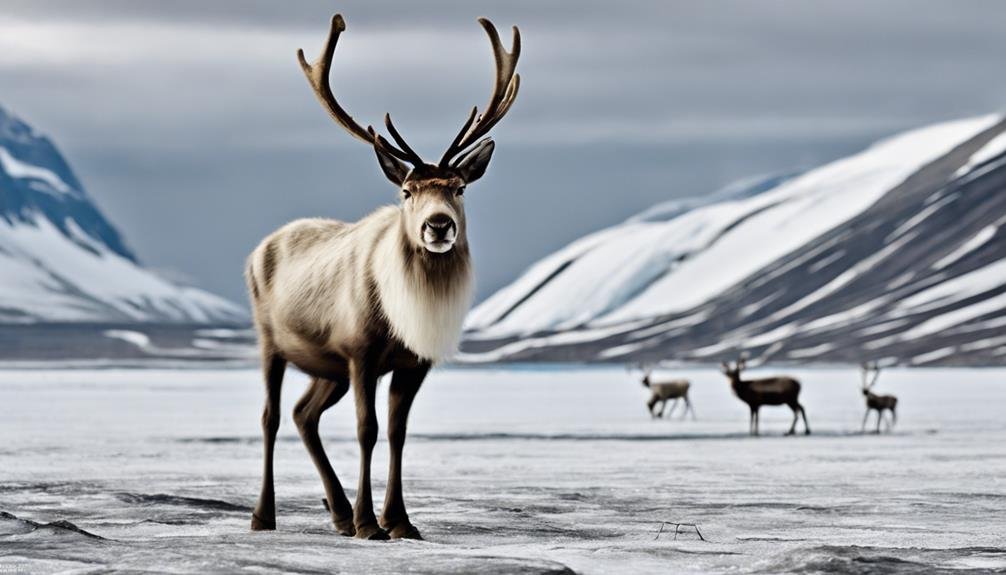
Facing the harsh realities of climate change, Svalbard reindeer are encountering increased challenges in accessing their food sources. The impacts of these environmental shifts are multifaceted, affecting not just the immediate availability of food, but also the broader ecosystem dynamics that sustain these Arctic inhabitants.
- Rain-on-Snow Events: The phenomenon of climate change has led to an increase in rain-on-snow events. This results in layers of ice that seal off the ground, making it challenging for reindeer to access their plant-based food sources.
- Warmer Winters: An uptick in temperatures causes more frequent ice formation on pastures. This significantly decreases the available feeding grounds for Svalbard reindeer.
- Permafrost Thawing: The thawing of permafrost introduces physical hazards, like sinkholes, into the reindeer’s habitat. These dangerous features can trap unsuspecting reindeer, posing a threat to their populations.
- Vegetation Changes: The flora in the Arctic is changing due to rising temperatures. This affects both the quality and availability of food for reindeer, impacting their overall health and ability to survive.
- Predator-Prey Dynamics: Climate change could alter the populations of predators in the Arctic. This has the potential to upset the existing balance of predator-prey interactions, increasing the risk of predation for Svalbard reindeer.
These challenges highlight the fragile balance that Svalbard reindeer must maintain to thrive in their rapidly evolving Arctic environment.
Other Interesting Facts
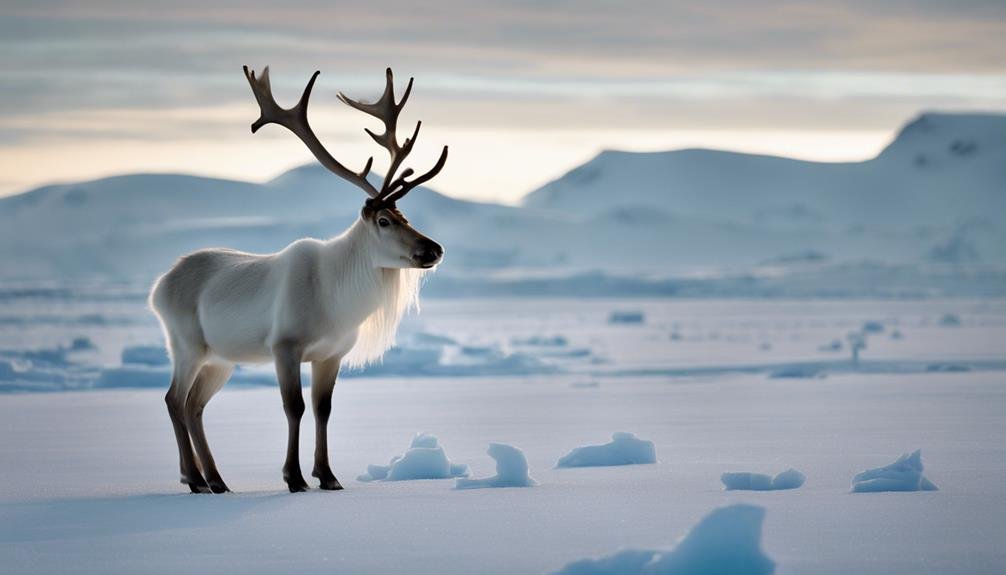
A Glimpse into the Arctic Survival of Svalbard Reindeer
The Arctic, a region of extreme conditions, is home to a unique species of reindeer. The Svalbard reindeer have carved out a niche for themselves in this inhospitable landscape. Their story of survival and adaptation is a remarkable one, stretching back over 5,000 years.
From the Brink of Extinction to a Flourishing Population
Not long ago, the Svalbard reindeer were facing a dire future. With their numbers reduced to a critically low level by 1925, their existence was hanging by a thread. Yet, by 2019, their population made an extraordinary comeback, reaching approximately 22,000 individuals. This resurgence highlights their incredible adaptability and resilience in the face of adversity.
The Dietary Habits Fueling Survival
At the heart of their survival strategy is their diet, which is perfectly attuned to the Arctic’s offerings. During the brief Arctic summer, they feast on the tundra’s vegetation, accumulating fat reserves that will see them through the winter. This ability to store energy efficiently is a key factor in their survival during the lean months.
Adaptations to the Arctic Environment
The Svalbard reindeer have developed a range of adaptations that enable them to thrive in the Arctic. Their fur, for instance, isn’t just a layer of warmth but also acts as a camouflage, blending seamlessly with the Arctic landscape and shielding them from predators. This combination of dietary and physical adaptations ensures their success in one of the planet’s most challenging environments.
The Role of the Svalbard Reindeer in the Arctic Ecosystem
As the only large grazing mammal in the European High Arctic, the Svalbard reindeer play a crucial role in their ecosystem. Their presence and grazing habits influence the composition of the Arctic tundra, demonstrating the interconnectedness of life in this extreme habitat.
Through their remarkable journey of adaptation and recovery, the Svalbard reindeer not only survive but flourish in the Arctic, embodying the resilience of life in extreme conditions.
Are Svalbard Reindeer and Caribou the Same Species?
Svalbard reindeer and caribou are indeed the same species, but they have adapted to their respective environments in different ways. Svalbard reindeer are smaller and have shorter legs due to living in a harsher climate. Caribou, on the other hand, migrate long distances and have some interesting caribou facts associated with their behavior.
Frequently Asked Questions
What Are Some Interesting Facts About Svalbard Reindeer?
What adaptations do Svalbard reindeer have?
Svalbard reindeer are a dwarf species that have adapted to their environment through genetic isolation. Their coats change to survive the winter, they face predation challenges, exhibit unique social behaviors, and have specific breeding seasons that influence their population dynamics and the impact of climate change.
How do Svalbard reindeer survive the winter?
Svalbard reindeer adapt their coats for winter survival. They grow thicker, warmer fur to protect against the harsh Arctic cold, ensuring they can maintain their body heat even in extreme temperatures.
What challenges do Svalbard reindeer face from predators?
Despite being in a remote location, Svalbard reindeer still face predation challenges. Their main predators include Arctic foxes and polar bears, especially during the harsher winter months when food is scarce.
What is unique about Svalbard reindeer social behavior?
The social behavior of Svalbard reindeer is distinct; they are less social than other reindeer species. They tend to form smaller groups or remain solitary, a behavior that is thought to be an adaptation to the sparse vegetation of their habitat.
How does the breeding season affect Svalbard reindeer?
The breeding season of Svalbard reindeer has a significant impact on their population dynamics. It is timed so that calves are born in the spring when food is becoming more abundant, which increases the chances of calf survival and, consequently, influences the population growth and structure.
How Many Reindeer Are There in Svalbard?
Q: How many reindeer are in Svalbard?
A: There are approximately 10,000 reindeer in Svalbard. Research into their population trends has shown resilience and adaptation to the harsh conditions, despite facing challenges from predation and interactions with humans.
What Do Reindeer Eat on Svalbard?
Q: What do reindeer eat on Svalbard?
A: On Svalbard, reindeer adapt their diet to include grasses, herbs, and shrubs. These food sources allow them to meet their nutritional needs, especially important for surviving the harsh climates and overcoming feeding competition. During summer, they focus on feeding to store fat for winter survival.
How Long Do Svalbard Reindeer Live?
Q: How long do Svalbard reindeer typically live?
A: Svalbard reindeer have a lifespan of up to 10 years. Their longevity is influenced by factors such as climate conditions, predation, and health issues. Their adaptations for survival, like the age they start reproducing and their resistance to diseases, also play a crucial role in determining their lifespan.
How Do Svalbard Reindeer and Arctic Wolves Interact in the Wild?
In the wild, Svalbard reindeer and Arctic wolves engage in a unique predator-prey relationship. Arctic wolves rely on their hunting skills to track and pursue reindeer. Some key arctic wolf characteristics include incredible endurance, strong teamwork, and sharp instincts—all essential for survival in the harsh Arctic environment.
Do Northern Fulmars and Svalbard Reindeers Share Similar Adaptations to the Arctic Environment?
Both northern fulmars and Svalbard reindeer have evolved specialized adaptations to survive in the harsh Arctic environment. The northern fulmar can withstand extreme cold and hunt in frigid waters, while Svalbard reindeer have thick fur for insulation. For more northern fulmar information, their robust physiology supports long-distance flight in cold conditions.
Conclusion
The Svalbard reindeer stands as a testament to the incredible capacity for adaptation within the animal kingdom. Thriving in the demanding conditions of the Arctic, they’ve evolved to exploit the sparse tundra vegetation efficiently.
This specialized diet, along with distinctive behaviors tailored for survival in extreme climates, underscores their evolutionary success. Efforts to conserve the species have shown positive outcomes, reversing their once dwindling numbers and showcasing the impact of focused conservation initiatives.
Yet, the shadow of climate change looms large, threatening their habitat and, by extension, their future. It underscores the urgent need for continued research and the development of adaptive strategies to safeguard the Svalbard reindeer against the challenges of a warming Arctic.
The journey of the Svalbard reindeer from the brink of extinction to a symbol of conservation success highlights the critical importance of preserving biodiversity in our ever-changing world.

